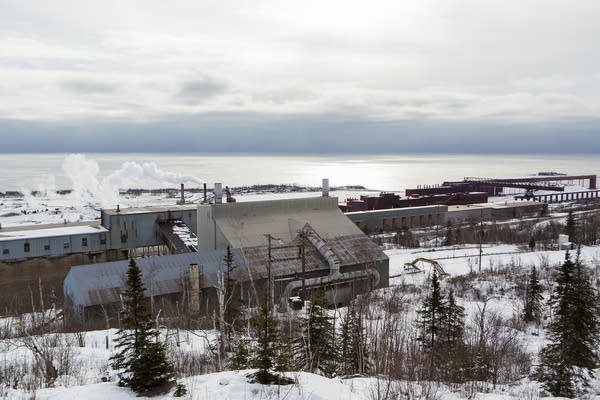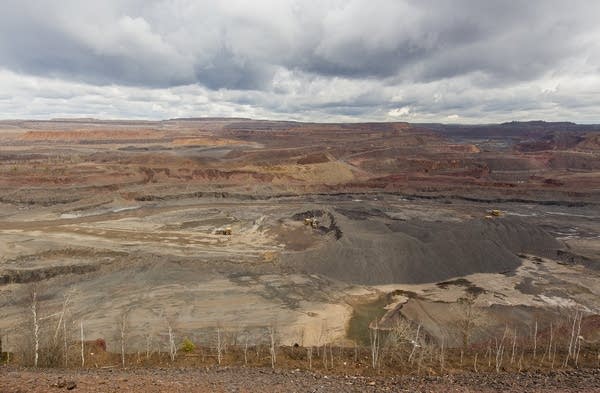Explaining the Iron Range downturn: Layoffs amid the challenges of a global economy

Go Deeper.
Create an account or log in to save stories.
Like this?
Thanks for liking this story! We have added it to a list of your favorite stories.
Iron deposits in Minnesota's northeastern quadrant have given the state's Iron Range its name and its purpose — but they've also set the region along the boom-and-bust roller coaster of a mining-based economy.
Minnesota's iron ore mining industry has been hit hard by a surge in steel imports to the United States. As a result, American steel companies have curbed production, which has meant a steep drop in demand for taconite pellets from the Iron Range.
That, in turn, has led to the closure of iron ore mines and production facilities on the Iron Range.
Thousands have been laid off — from the mines themselves and from the businesses that rely on them — in the past year alone.
Turn Up Your Support
MPR News helps you turn down the noise and build shared understanding. Turn up your support for this public resource and keep trusted journalism accessible to all.
What, exactly, is going on?

Seven of the 11 iron ore mining and production facilities on the Iron Range have been shut down.
Nearly 2,000 people who work directly in mining facilities on the Iron Range have been laid off.
In addition, there are about 4,700 additional workers on the Iron Range who have been laid off from the construction, manufacturing or wholesale trades. Some of those jobs include contractors and suppliers to the mines, but there isn't data to show exactly how many jobs have been lost because of the mining downturn.
Nearly 2,400 mining-related workers filed unemployment insurance claims in 2015.
What's causing the downturn in the mining industry?

Minnesota's mines ship their iron ore to U.S. steelmakers, primarily around the Great Lakes. But those U.S. steelmakers have been hurt by a surge in steel imports, largely from China.
In 2015, steel imports accounted for a record 29 percent of market share. That caused domestic steelmaking capacity to drop to 70 percent, and caused the closure of many steel mills.
That, in turn, meant U.S. steel companies did not need nearly as much Minnesota iron ore, and led to the closure of several Minnesota mining facilities, which led to layoffs.
Are the imports illegal?
The U.S. Department of Commerce has ruled that several different kinds of steel from certain countries, including China, have been illegally "dumped" into the U.S. market. That means it's been sold here at below the cost of production. Many foreign steel companies can afford to do that because they're subsidized by their governments.
But imports are also surging because of increases in steel production worldwide. That's happening primarily in China, where steelmaking capacity has grown from 100 million tons in 2000 (roughly the same as the U.S.) to 1.2 billion tons today. Imports have also grown because of a strong U.S. dollar, and weakened demand for steel in China as its construction boom has slowed.
Is there any indication these imports are slowing?
Yes. Cliffs Natural Resources has announced it will reopen Northshore Mining in Babbitt and Silver Bay in May.
In making the announcement, Cliffs CEO Lourenco Goncalves said, "with the trade cases approaching their final stages and preliminary duties being announced, the volume of unfairly traded steel is starting to subside."
Cliffs has also indicated it anticipates reopening United Taconite in Eveleth and Forbes by the end of 2017.
How big of a problem is this downturn for the Iron Range economy?

It's big, although not as large as some might expect. About 4,500 people work in mining in the region.
That accounts for about 7 percent of total jobs on the Range. Yet it makes up more than 17 percent of the region's total payroll. That's because the average mining wage — about $90,000 — is higher than any other sector in the area.
Additionally, the Iron Range Resources and Rehabilitation Board estimates that each mining job on the Range creates another 1.5 to two jobs for the region.
How does this downturn compare to past down cycles on the Iron Range?

In the 1980s, some 10,000 workers — more than 60 percent of Minnesota's mining workforce — lost their jobs.
In 2001, 1,400 mineworkers lost their jobs when LTV Mining closed in Hoyt Lakes.
In 2009, more than 1,000 were laid off when several mines were temporarily idled, although the industry rebounded the following year.
In the past year, nearly 2,000 mineworkers were laid off.
Anecdotally, many people on the Iron Range say this downturn feels different. Unlike in 2009, when the entire country was in a recession, this time, the Range is struggling while Minnesota's economy as a whole is relatively healthy.


